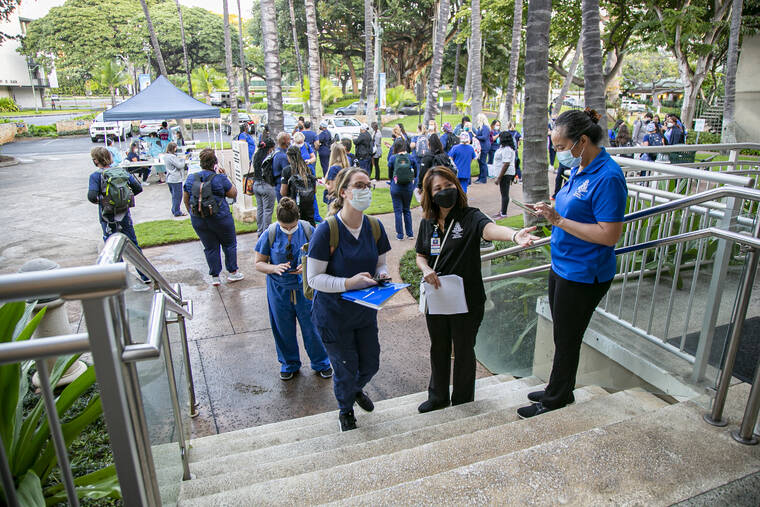The first wave of health care personnel from abroad has arrived in Hawaii to help care for patients, just ahead of what some say is an expected peak in daily coronavirus cases this week.
Lt. Gov. Josh Green said Monday on the Honolulu Star-Advertiser’s “Spotlight Hawaii” livestream program that 350 health care personnel arrived this week through anticipated funding from the Federal Emergency Management Agency, with more expected to come next week.
More than 100 arrived over the weekend to help at Queen’s, according to The Queen’s Health Systems, and will undergo orientation before deployment. The supplemental staff includes nurses, respiratory therapists and a radiologic technologist who will work at The Queen’s Medical Center-Punchbowl and QMC-West, both of which recently declared an “internal state of emergency” due to staffing shortages.
Green said he believes the peak in daily COVID-19 cases will occur sometime this week, followed by a peak in hospitalizations.
“The COVID pandemic has chewed up and spit out a whole lot of public health workers, and I want to thank them for all of the hard work they’ve done over these two years,” said, “but we’re still going to have a lot more work to do in the next few months.”
The estimated cost of bringing about 900 medical personnel requested to Hawaii to help care for patients over eight weeks is about $90 million, he said, to be covered by FEMA.
On Monday the state Department of Health reported 4,700 new coronavirus infections, bringing Hawaii’s total since the start of the pandemic to 174,586 cases. No new virus-related fatalities were reported, and Hawaii’s COVID-19 death toll remained at 1,126.
The seven-day average of new cases statewide rose to 3,705 Monday, while the average positivity rate remains unknown.
As previously reported, DOH temporarily paused reporting the positivity rate as of Sunday because the state’s system has been overwhelmed by the number of test results it is trying to process. The pause might last for at least two weeks, which includes when some think the peak might occur.
As of Monday the state had more than 50,000 active cases, according to health officials.
On Monday the Hawaii Emergency Management Agency dashboard listed 346 patients with COVID-19 in hospitals, with 41 in intensive care and 19 on ventilators. HI-EMA collects the data from hospitals starting at midnight of the day the numbers are reported.
Green independently reported 356 patients with COVID-19 were in hospitals Monday, with 39 in intensive care, based on reports he gets every morning directly from hospital administrators, he said.
Though the two hospitalization numbers differ, both represent an increase over the previous day as well as the previous week. Hospitalizations have been increasing since mid-December.
Green said the delta variant was five times more likely to land people in hospitals than omicron, based on comparisons between the hospitalization rates then and now.
Those who are landing in the hospital include “those who had no vaccination whatsoever” and were extremely vulnerable, he said, as well as those who are older, with underlying chronic conditions such as heart or lung disease.
But people in their 30s and 40s who could not be vaccinated for health reasons have also landed in intensive care, he said, and had to be intubated.
More of the patients in hospitals during this surge also have been vaccinated with two doses, he said, noting 143 out of 356 fit that criterion Monday. He urged all eligible residents, estimated at about 500,000, to get boosted.
As of Friday, DOH reported, 75.2% of the state’s population is fully vaccinated, with 81% receiving at least one dose, and 30% boosted.
When asked, Green said boosters should be added to requirements for the Safe Travels program, which allows domestic travelers to Hawaii to bypass a five-day quarantine if they can show proof of full vaccination — defined as two doses of Pfizer or Moderna or one dose of Johnson & Johnson — or a negative COVID-19 test 72 hours prior to arrival.
“It should be made (modified), and it should be boosted or tested,” he said. “It’s got to be straightforward and simple. Otherwise it will create chaos.”
Requesting that travelers be both boosted and tested would be more complicated, he said, noting that “there aren’t enough tests out there in the universe” to do that.
Green said he and Gov. David Ige are discussing the changes, and that he anticipates seeing the booster included in requirements for Safe Travels by February, but that realistically, it might not happen until mid-February.
Ige, on an earlier “Spotlight Hawaii,” said if such a change were made, he would give the community at least two weeks to prepare for it.
Green also shared that his son, Sam, 11, contracted COVID-19 about three months ago after a classmate from his public charter school tested positive for the coronavirus, prior to vaccinations becoming available for children ages 5-11. Sam did not require a visit to the doctor, and is now doing all right, Green said. Sam is also now vaccinated.
Green said once again that he thinks schools should move forward with in-person classes for all the benefits they provide to students.
Green said following the peak in COVID-19 cases, which he expects by February, there will likely be a more gradual decline over several weeks rather than a steep plummet.
The Hawaii Pandemic Applied Modeling Work Group, a volunteer group of epidemiologists and data scientists, also predicted the peak would occur sometime this week.




